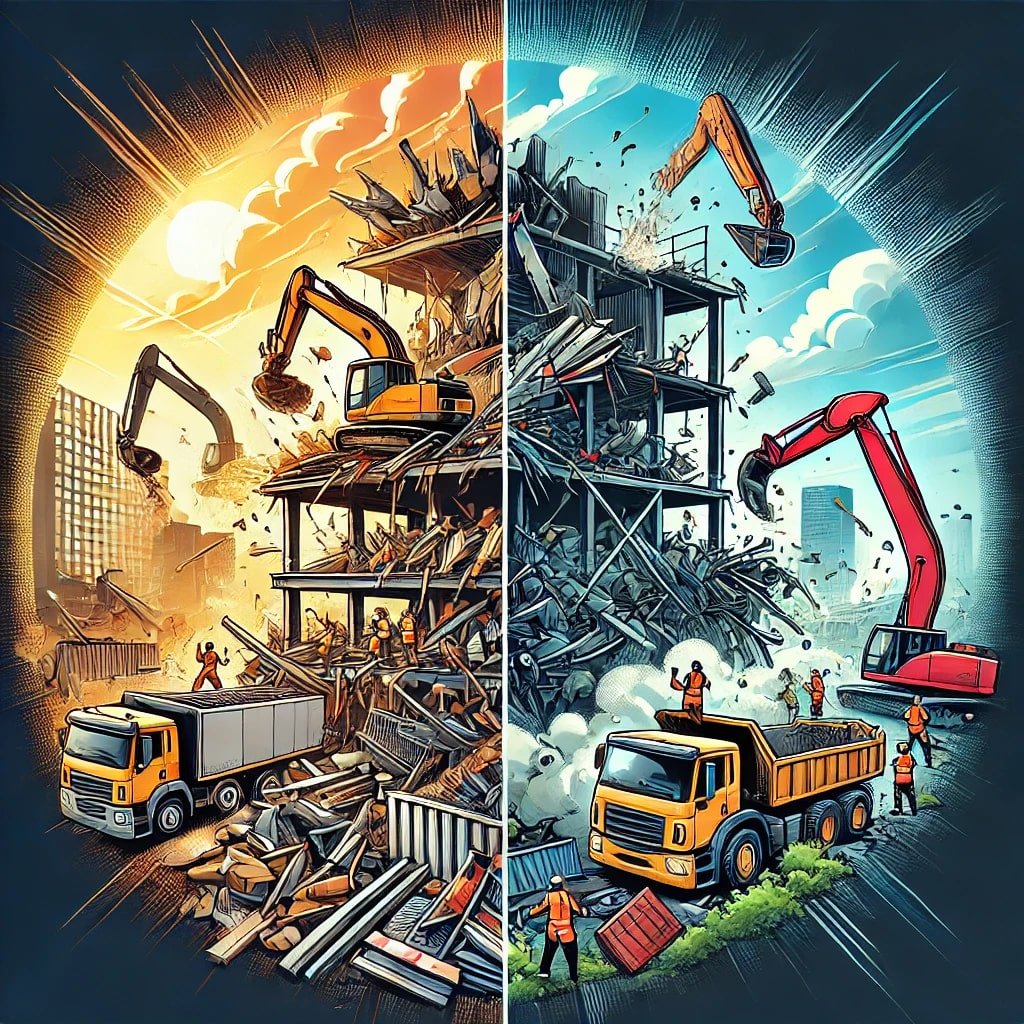When it comes to tearing down buildings, two terms often come up: demolition and deconstruction. While both processes involve the dismantling of structures, they differ significantly in methodology, environmental impact, and purpose. Understanding these differences can help you choose the best approach for your project. Here’s a closer look at the distinction between demolition and deconstruction.
What is Demolition?
Demolition is the process of tearing down a building quickly and efficiently. This method is often used when a building is structurally unsound, poses a hazard, or when there is an urgent need to clear a site for new construction.
Key Characteristics of Demolition:
-
Speed: Demolition is typically completed much faster than deconstruction. Heavy machinery such as wrecking balls, bulldozers, and explosives are often used to bring down structures in a matter of hours or days.
-
Cost: Demolition is usually less expensive than deconstruction due to the shorter timeframe and the use of less labor-intensive methods.
-
Waste: Demolition generates a significant amount of waste, as materials are often not salvaged and are instead sent to landfills. This contributes to environmental degradation and increased waste management costs.
-
Safety: While demolition is conducted under strict safety protocols, the use of explosives and heavy machinery can pose risks to workers and nearby structures.
When to Choose Demolition:
-
When time is of the essence, and a site needs to be cleared quickly.
-
When a building is beyond repair and poses a safety hazard.
-
When the cost of deconstruction and material salvage outweighs the benefits.
What is Deconstruction?
Deconstruction is the systematic dismantling of a building with the intent to salvage and reuse as many materials as possible. This method aligns with sustainable building practices and aims to minimize waste and environmental impact.
Key Characteristics of Deconstruction:
-
Sustainability: Deconstruction prioritizes the recovery of reusable materials such as wood, metal, fixtures, and architectural elements. These materials can be repurposed or sold, reducing the need for new resources and decreasing landfill waste.
-
Labor-Intensive: Deconstruction requires more time and labor compared to demolition. Skilled workers carefully dismantle the structure piece by piece to ensure materials are salvaged intact.
-
Environmental Impact: By reducing the amount of waste sent to landfills and reusing materials, deconstruction significantly lowers the environmental footprint of a building’s end-of-life process.
-
Cost: While the initial cost of deconstruction may be higher due to the labor and time involved, the resale of salvaged materials can offset some of these costs. Additionally, tax incentives and grants are sometimes available for sustainable practices.
When to Choose Deconstruction:
-
When sustainability and environmental impact are top priorities.
-
When there is a market for reclaimed materials, and these materials can be resold or repurposed.
-
When the building contains valuable architectural elements or historic materials that can be preserved.
Combining Demolition and Deconstruction
In some cases, a hybrid approach may be the best solution. For example, selective deconstruction can be employed to salvage valuable materials before the remaining structure is demolished. This method combines the benefits of both processes, allowing for some material recovery while still achieving a relatively quick site clearance.
Benefits of a Hybrid Approach:
-
Maximizes the salvage of reusable materials.
-
Reduces overall project cost by balancing labor-intensive deconstruction with faster demolition techniques.
-
Minimizes environmental impact by diverting some waste from landfills.
Conclusion
Choosing between demolition and deconstruction depends on various factors, including project timeline, budget, environmental goals, and the condition of the building. Demolition offers speed and lower initial costs but generates significant waste. Deconstruction, on the other hand, aligns with sustainable practices by salvaging materials and reducing environmental impact, though it requires more time and labor.
At Deconstructors, we are committed to offering both demolition and deconstruction services tailored to your specific needs. Our experienced team can help you determine the best approach for your project, ensuring efficiency, safety, and sustainability. Whether you’re clearing a site for new development or looking to preserve valuable materials, we have the expertise to handle your project with care and professionalism.
For more information on our services and how we can assist with your next project, contact us today! Together, we can build a better, more sustainable future.


